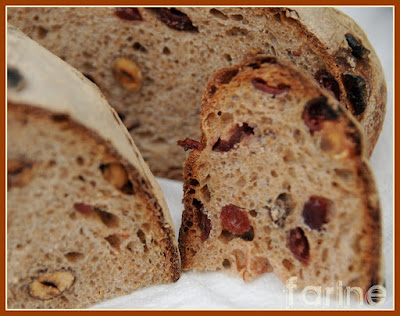

(The following recipe is loosely based on the Walnut Currant Bread featured in The Baking Sheet, Vol. XVIII, no. 1, Winter 2007)
Ingredients
For the levain
114 g whole wheat flour
114 g water, at cool temperature
30 g firm levain (hydration: 65%) (I used whole-grain levain as explained above but if all you have is liquid levain, you can use it instead. Just adjust the water amount accordingly)
For the final dough
all of the levain
340 g whole wheat flour
241 g unbleached all-purpose flour
455 g water, at cool temperature
14 g salt
125 g dried cranberries (mine were slightly sweetened)
100 g hazelnuts (roasted in the oven and peeled by rubbing them together in a kitchen towel), cooled
Method (this bread is made over two days)
The night before baking day
Combine flour, water and levain, mix well, cover and leave to ferment overnight (or for up to 12 hours)
On baking day

- Combine all of the levain with the remaining flours and the water and mix (since I don't have a mixer here at my kids' house, I mixed by hand) until the flours are thoroughly hydrated
- Cover the bowl and let rest for 20 minutes (autolyse)
- Add the salt and mix briefly or until the dough is smooth and cohesive (I used the stretch and fold method of hand mixing)
- Cover the bowl and let rest for 30 minutes
- Turn the dough out onto a well-floured surface and, wetting or flouring your hands (depending on the dough consistency), lightly pat it into a rectangle
- Sprinkle the cranberries over it and using a metal bench knife, fold it like a business letter over the cranberries
- Pat the dough out into a rectangle again, sealing in the cranberries and sprinkle with the roasted hazelnuts
- Using a metal bench knife, fold the dough again as a business letter but this time in the opposite direction to seal the hazelnuts in
- Put the dough back in the bowl and let it rest, covered for another 30 minutes
- After 30 minutes, take the dough out and give it another business letter fold on a well-floured surface
- Brush the extra flour off and return to the bowl and repeat the rising and folding twice more
- After 4 folds and 2 ½ hours of rising time, heavily flour two bannetons or colanders lined with linen towels
- Turn the dough from the bowl onto a lightly floured surface and divide in two (since I had different size colanders, I divided the dough roughly in two thirds and one third)
- Pre-shape into rounds, let rest covered 10 minutes and shape into balls
- Be careful not to tighten the balls too much or the nuts and berries will tear the surface of the skin of the dough
- Turn the loaves upside down into the prepared bannetons or colanders, cover them well and let them rise for 2 to 2 ½ hour
- About half-an-hour before the loaves are ready to bake, preheat the oven to 450° F/232° C with a baking stone in it (having no baking stone here, I preheated the oven with a thick metal baking sheet on the middle shelf and a metal pan on the bottom)
- Flip the loaves out of the bannetons onto a piece of parchment paper, gently brush off the excess flour (preferably with a pastry brush if available), slash in desired pattern and use a peel (I used another baking sheet) to load them into the oven
- Pour a cup of cold water in the prepared metal pan and close the oven door
- After 20 minutes, turn the loaves around and continue baking for another 20 minutes, removing the metal pan if there is any leftover water
- After 40 minutes' total baking time, turn off the oven and leaving the oven door slightly ajar (I used a wooden spoon to prevent it from closing completely), let the loaves dry out for about 10 minutes
- Take them out of the oven and set them on a rack to cool.

The Cranberry-Hazelnut Whole Wheat Bread goes to Susan's Wild Yeast for Yeastspotting.

















Wow this looks good... i have stock of hazelnut and cranberries which can be put to good use now
ReplyDeleteI love hazelnuts too, we used to make escargot with garlic, parsley butter with ground hazelnut flour!
ReplyDeleteHave you settled in the Pacific Northwest now?
Fall is coming soon here, I miss summer for tomatoes and a fresh farm vegetables, but the heat you can have!
Cheers and happy baking!